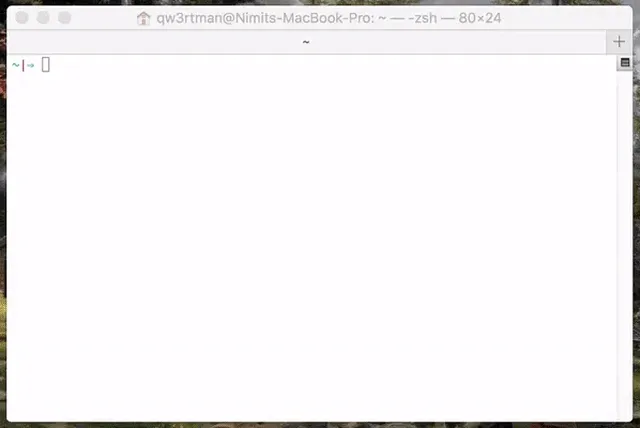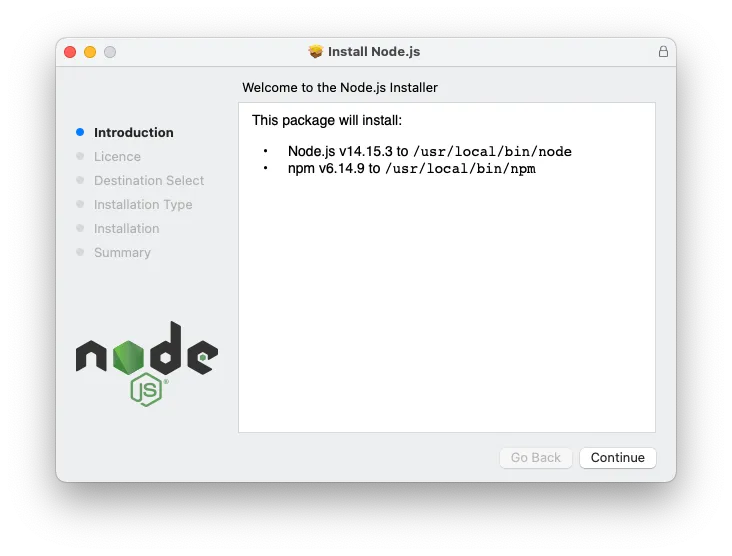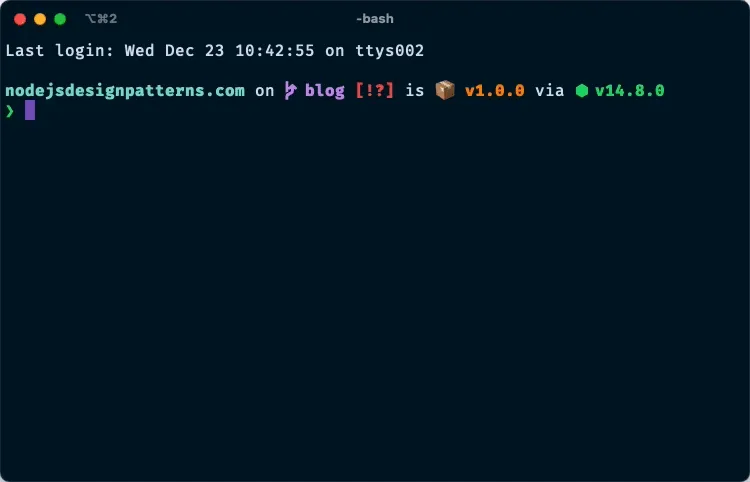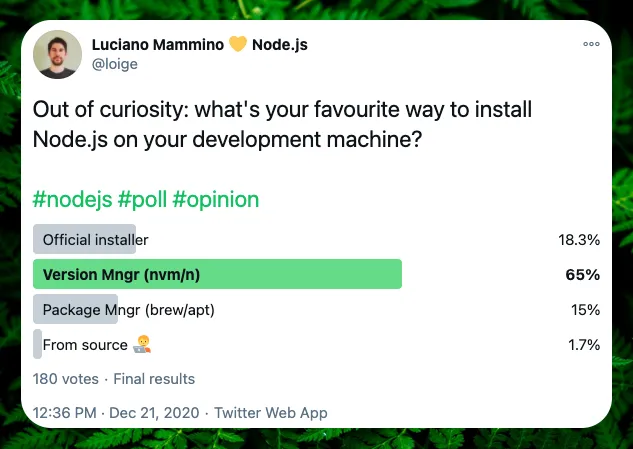Table of Contents
In this article, we will explore some of the most common ways to install Node.js in your development system. We will see how to install Node.js using the official installer for various platforms, how to use a Node.js version manager such as n or nvm and, finally, we will also see how to compile and install Node.js from source. Along the way, we will try to disclose one or two tips to get you even more productive with Node.js!
Let’s get started!
Which option should I pick?
There are many different ways to install Node.js and every one of them comes with its own perks and drawbacks. In this article, we will try to explore the most common ones and by the end of it, you should have a good understanding of which ones should be more suitable for you.
TLDR;
- Use
nvmornif you develop with Node.js frequently and you expect to be needing to switch Node.js version while moving from one project to another or to debug potential compatibility issues in your project or library. - Use the system package manager like
apt,breworwingetif you tend to install all your software this way and if you don’t expect to be needing to switch or upgrade Node.js version too often. - Install Node.js from source if you are an advanced user and if you want to contribute back to Node.js itself.
- Use the official Node.js installer if you don’t fall in any of the previous options…
What other people seem to like
Before writing this article, I was actually curious to find out what are the options that most folks in my network prefer. For this reason, I run a poll on Twitter. In this poll I asked how you prefer to install Node.js and provided 4 options:
- Official Installer
- Version manager (
nvmorn) - Package Manager (
apt,brew, etc.) - From source
The results are quite interesting:
It seems quite obvious that people in my network, mostly fellow software engineers, prefer to use version managers such as nvm or n.
The second place (actually very tight with the third one) is the official installer, followed by a system package manager and, last one, installing Node.js from source.
LTS and stable releases
Before moving on and exploring all the different installation options, it is definitely worth spending few words to learn about the types of release the Node.js project maintains.
Node.js offers 2 main release lines:
- Stable (or Current): every new major Node.js release is considered “Current” for the first 6 months after the publish date. The idea is to give library authors the time to test their compatibility with the new release and do any necessary change. After the 6 months period, all the odd release numbers (9, 11, 13, 15, etc.) move to the state of Unsupported, while even releases (10, 12, 14, etc.) are promoted to Long Term Support (or “LTS”).
- LTS: releases marked as “Long Term Support” get critical bug fixes for a total of 30 months since the initial publish date. This makes LTS releases particularly suitable for production deployments. The most recent LTS is also called Active LTS, while previous LTS versions (still under the 30 months support timeframe) are called Maintenance LTS.
Finally, the release coming from the current master branch is considered Unstable. This is generally a release dedicated to people maintaining Node.js or developers who want to explore new experimental features that haven’t been yet included in any of the major releases.
Node.js publishes an official timeline of current and future releases. At the time of writing (December 2020), this how the timeline looks like:
If you are still wondering which release should you use, going with the Active LTS is almost always the best choice, especially if you are building production applications.
Install Node.js using n
Since installing Node.js using a version manager seems to be the favourite option (and it’s also my personal favourite!) let’s start with it.
My favourite Node.js version manager is n by TJ Holowaychuk. The reason why I like it is because it is quite simple to install and use and it is generally up to date with the latest releases of Node.js.
The main issue with it is that it does not support Windows, so if Windows is your operative system, this is not an option for you!
Let’s see how to install n:
If you are on macOS and you have brew (Homebrew) installed, the simplest way to install n is to just do it with brew:
brew install nAlternatively, you can use the custom install script:
curl -L https://git.io/n-install | bashNote: if you are concerned about running a script downloaded from the web (as you should because curl | bash might be dangerous), you can always download the script first, READ IT, and then run it locally…
If all goes well, you should now be able to use the n executable from your shell.
These are some of the commands you can run:
# shows the version of `n` installed in your systemn --version
# installs the latest LTS release of Node.jsn lts
# lists all the versions of Node.js currently availablen list
# install the given version of Node.js and switch to itn <some_version>Or you can simply run:
nFor an interactive prompt that will show you all the available versions, highlight the ones you have already installed and let you pick the version you want to switch to.

In summary, this is where n shines or falls short:
- 👎 No official support for Windows
- 👍 Very easy to install on macOS and unix systems
- 👍 Very easy to keep your Node.js install up to date and switch version on demand
- 👍 It keeps all the installed versions cached, so you can switch quickly between versions (no full re-install)
- 👍 Allows to keep the setup local to the user so you don’t have to use admin permission to install global packages
Install Node.js using nvm
With more than 45 thousand stars on GitHub, nvm, which stands for “Node.js Version Manager” (no surprises!), is probably the most famous Node.js version manager currently available.
nvm works on any POSIX-compliant shell (sh, dash, ksh, zsh, bash, etc.) and it has been strongly tested against the following systems: unix, macOS, and windows WSL (if you are on Windows, you can also check out nvm-windows).
The easiest way to install nvm on your system is to use the official installer script:
VERSION=v0.37.2curl -o- "https://raw.githubusercontent.com/nvm-sh/nvm/${VERSION}/install.sh" | bashNote: At the time of writing, version v0.37.2 is the latest version available. Make sure to check out if there is any new version available if you are installing nvm following this tutorial.
Once nvm is installed in your system, here are some examples showing what you can do with it:
# installs the latest version of Node.jsnvm install node
# installs the latest LTS version of Node.jsnvm install --lts
# installs a specific version of Node.jsnvm install "10.10.0"
# switch to a specific version of Node.jsnvm use "8.9.1"
# runs a specific script with a given version of Node.js (no switch)nvm exec "4.2" node somescript.js
# shows the full path where a given version of Node.js was installednvm which "4.2"
# lists all the versions of Node.js availablenvm lsOne great thing about nvm is that it allows to specify the Node.js version you want to use for a given project.
For instance, if you are working on a project that requires you to use Node.js 10.10 you can do the following (in the root folder of the project):
echo "10.10" > .nvmrcThen every time you work on that project, you only need to run:
nvm useWhich should print something like this:
Found '/path/to/project/.nvmrc' with version <10.10>Now using node v10.10.1 (npm v6.7.3)At this point, you can be sure that you working using the correct Node.js version for your project.
If you don’t want to do manually, you can enable deeper shell integration to make this happen automatically when you cd into a folder that has a .nvmrc file.
PRO tip: You can also do that by using asdf, a meta version manager that offers a unified interface for various programming languages and version managers (including Node.js, of course).
Finally, here are some pros and cons of nvm:
- 👍 Most popular version manager for Node.js with a large community of users.
- 👍 Very easy to install on POSIX systems.
- 👍 It allows for easy (and even automated) switch of Node.js version based on the project you are working on.
- 👍 It keeps all the installed versions cached, so you can switch quicly between versions (no full re-install)
- 👍 You can run once off commands on a given version of Node.js without having to switch the entire system to that version.
- 👎 You might have to take a bit of time to go through the documentation and make sure you install it and use it correctly.
Note: if you like to use version managers like n or nvm, you can also check out volta.sh, another interesting alternative in this space, which defines itself as “The Hassle-Free JavaScript Tool Manager”.
Install Node.js using the official installer
The second most common way to install Node.js is through one of the official installers or the pre-compiled binaries.
Official installers are available on the official Node.js website for Windows and macOS and they cover the latest Active LTS release and the latest Current release.
The installer for Windows is an executable .msi installer, while the one for macOS is a .pkg one.
These installers behave and look like most of the installers you see while installing software on Windows or macOS. You will be presented with clickable UI which will allow you to customise and install Node.js into your system.

This is probably the easiest way to install Node.js as you don’t need to be a POSIX expert or do any kind of manual configuration. The installer will suggest sensible defaults to you and allow you to customise the main parameters (e.g. installation path).
If you are running a unix system, there is no official graphical installer available, but the official Node.js download page offers a set of pre-compiled binaries for most architectures (32-bit, 64-bit, ARMv7 and ARMv8) for Linux, Windows and macOS.

With the binary distribution, it is up to you to copy the necessary files in the right place. A version manager tool such as nvm and n makes things simple, because it takes care of downloading the correct binary release for the desired version (and for your system), then it places the files in the correct folder as expected by your operative system. If you choose to download the binaries manually, all the wiring is up to you.
While installing Node.js using the official installers is probably the simplest option, doing it using the binaries is a lot more complicated and definitely more complicated than using a version manager.
If you still want to go down this path, make sure to check out the official tutorial for installing from Node.js pre-compiled binaries.
It is definitely worth mentioning that the official installer is not the only option. NodeSource maintains alternative installers for Debian, Red Hat, macOS and Windows. If you are interested in this approach checkout NodeSource Node.js Binary distributions page.
To summarise, these are the main pros and cons of Node.js installers and binary distributions:
- 👍 Installers are quite easy to use and they don’t require specific POSIX experience.
- 👎 Hard to switch between version or upgrade. If you want to do that, you basically have to download the specific installer for the desired version and run through the full process again.
- 👎 Installer often will install Node.js as admin, which means that you can’t install global packages unless you do that as admin.
- 👎 Binary packages require you to manually manage all the files and configuration.
Install Node.js using a package manager
If you are the kind of person that loves to install and manage all the software in your device using system package managers such as apt (Debian / Ubuntu), brew (macOS), or winget (Windows), installing Node.js through a package manager is definitely an option.
A word of warning though, the various Node.js packages in every package repository are not officially maintained by the Node.js core team, so your mileage might vary quite a lot. This also means that you might not have fresh releases available straight away in your package manager of choice.
The Node.js core team has compiled an official documentation page on how to install Node.js using the most common system package managers.
Let’s see here a summary for the most common options:
# Homebrew (macOS)brew install node
# Arch Linuxpacman -S nodejs npm
# CentOS, Fedora and Red Hat Enterprise Linuxdnf module list nodejs
# Debian and Ubuntu based Linux distributionsapt-get install -y nodejs
# FreeBSDpkg install node
# Gentooemerge nodejs
# Winget (Windows)winget install -e --id OpenJS.Nodejs
# Chocolatey (Windows)cinst nodejs.install
# Scoop (Windows)scoop install nodejsIn short, this is “the good” and “the bad” of following this approach:
- 👍 Familiar approach if you install software often using your system package manager.
- 👎 Latest Node.js versions might not be immediately available in your package manager of choice. Some versions might not be available at all.
- 👎 In most cases, Node.js is installed as super user, which makes it harder to install global packages with
npm.
Install Node.js from source
If you are brave enough to be willing to build and install Node.js from source, your first stop should be the official documentation on how to build Node.js from source.
Here is a brief summary of all the steps involved:
- Install the necessary build dependencies (C++ compiler and build toolchains) for your target system.
- Install Python (used by the build process).
- Download the source code from the official repository.
- Launch
./configureand thenmake. - Test your compiled version with
make test. - Install it with
make install.
If all went well, you should have the node binary available on your system and be able to run:
node --versionFinally, here is the usual summary of pros and cons:
- 👍 You can install any version of Node.js, including master or even work in progress from a dev branch or a PR. You can even play around with custom changes and get to the point where you might decide to contribute back to Node.js.
- 👍 You have full control on how to compile and install Node.js and don’t have to follow pre-defined structures.
- 👎 You might need to install a bunch of additional build requirements (compilers, build tools, etc.) before you can even start with the process.
- 👎 Definitely the most complicated and the slowest way to get Node.js in your machine.
Node.js with Docker
If you just want to “play” a bit with a Node.js REPL, you don’t need to install Node.js in your system. If you have docker installed in your system, running a Node.js REPL in a container is as easy as running:
docker run -it nodeHere’s a super quick demo:

If you want to run a shell in a container with Node.js and npm installed, then you can do the following:
docker run -it node bashThis way you can install third-party modules using npm, create your own scripts and run them with node. When you close the session the container and all the generated files will be destroyed.
This is the perfect environment for quick and dirty experiments.
Note, that you can also use Docker as a complete environment for development and not just for quick tests. Docker is actually great for keeping different Node.js version and other dependencies isolated on a per-project basis. Exploring this setup goes beyond the scope of this article, but there is ton of reference on the web about how you might use Docker for Node.js development.
Node.js online
But what if you don’t have docker installed and still want to have an environment where you can write and run some Node.js code?
Well, there is no shortage of platforms online that will give you a Node.js environment and an IDE that you can use to write and run JavaScript online.
These environments often offer delightful additional features like collaborative edit and the possibility to host and share your applications.
Here’s a non-exhaustive list of services that you might want to try if you just need a quick way to write and share some Node.js examples:
Most of these services offer a quite generous free plan, so you only need to sign up to start coding!
Conclusion
This concludes our list of ways to install Node.js. At this point, I hope you feel comfortable enough picking one of the options suggested here and that along the way you learned a trick or two.
If you enjoyed this article please consider sharing it and don’t hesitate to reach out to me on Twitter. I am quite curious to find out what is your favourite way to install Node.js and why!
Until next time!
Credits
This article was possible only thanks to the great support and feedback of some amazing engineers. Here are some of the names that helped me (and sorry if I am forgetting someone): @_Don_Quijote_, @GiuseppeMorelli, @oliverturner, @aetheon, @dottorblaster, @bcomnes & @wa7son.

